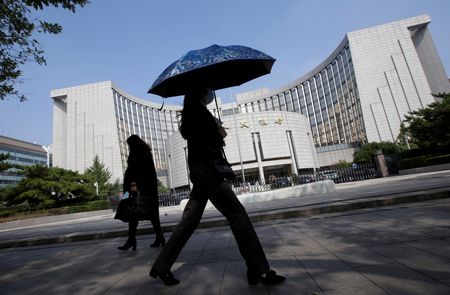BEIJING (Reuters) -China’s central bank will roll out more policy measures to stabilise the economy and move ahead of the market curve as downward pressure persists, vice governor Liu Guoqiang said on Tuesday, following the latest rate cut.
The world’s second-largest economy, which cooled over the course of last year, faces multiple headwinds in 2022, including persistent property weakness and a fresh challenge from the recent local spread of the highly contagious Omicron variant.
“Before the downward pressure on the economy is fundamentally relieved, we should introduce more policies that are conducive to stability, and should not introduce policies that are not conducive to stability,” Liu told a news conference.
“We should hurry up, make our operations forward-looking, move ahead of the market curve, and respond to the general concerns of the market in a timely manner.”
Liu said the central bank would widen the use of its policy tools to prevent a “collapse” in credit.
On Monday, the People’s Bank of China (PBOC) unexpectedly cut borrowing costs on its medium-term loans for the first time since April 2020.
Liu said there was still room for the central bank to cut banks’ reserve requirement ratios (RRR), although the scope for this had been reduced by cuts in the past.
The average RRR for financial institutions – the proportion of their deposits they must hold as reserves and not lend out – stands at 8.4%, he said.
China’s macro leverage ratio fell 7.7 percentage points in 2021 to 272.5%, Liu said, adding that falling debt levels would create more room for monetary policy. He expects the ratio to be basically stable this year.
LIQUIDITY
The PBOC would use various policy tools to keep liquidity reasonably ample, and guide financial institutions to expand credit, especially for small firms, tech innovations and green development, Liu said.
In 2022, the central bank would keep growth of money supply and total social financing basically in line with nominal economic growth, he said.
Sun Guofeng, head of monetary policy department at the PBOC, told the same briefing that the loan prime rate (LPR), the benchmark lending rate, would reflect the changes of market interest rates in a full and timely manner.
A cut in the LPR is widely expected on Jan. 20, following the MLF rate cut.
The PBOC last cut the RRR by a 50 basis points (bps) on Dec. 15, its second such move last year. That was followed by a 5 bps cut in the one-year loan prime rate (LPR), the benchmark lending rate, on Dec. 20.
Authorities would maintain an order in bank deposit markets to prevent poor-quality banks from raising rates to lure customers, as high deposit rates could make it difficult for banks to lower lending rates, Liu, the vice governor, said.
Sun said cross-border capital flows could show some volatility due to changes in international financial situations, but the impact from policy adjustments in developed countries, including the United States, would be limited.
The yuan exchange rate could deviate from its balanced levels in the short term, but over the medium and long term, market factors and government policy would help correct deviations, said Liu.
Zou Lan, head of financial markets at the PBOC, said the central bank would maintain “continuity, consistency and stability” of property financial policies.
Property sales and financing were gradually returning to normal, and market expectations are improving, he added.
At the end-2021, China’s total property loans rose 7.9% from a year earlier to 52.2 trillion yuan ($8.22 trillion), 0.3 percentage points faster than the end-September, he said. ($1 = 6.3525 Chinese yuan renminbi)
(Reporting by Kevin Yao and Stella Qiu; Editing by Clarence Fernandez, John Stonestreet and Alex Richardson)









